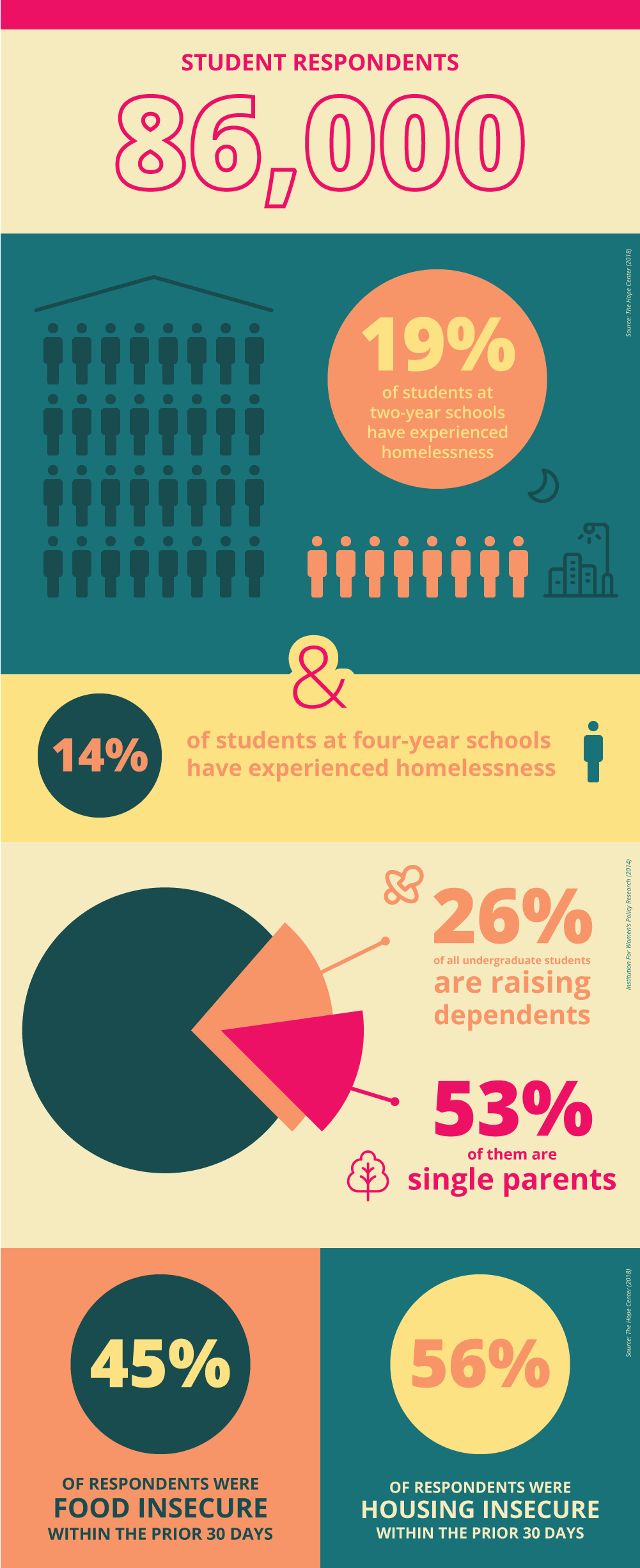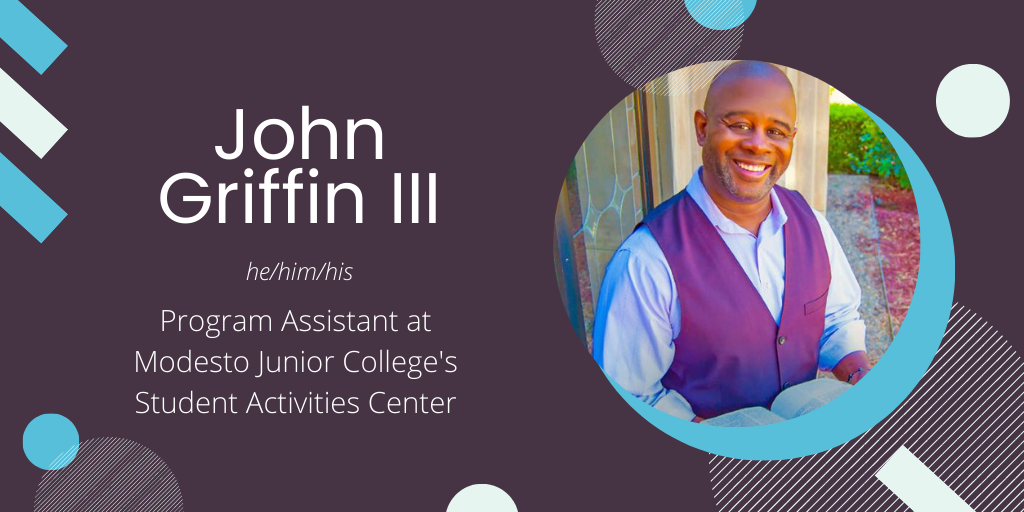We all like to think that our students are pursuing degrees to enhance an already comfy life.
But that’s not always the case. Many students are pursuing degrees during strenuous times; they’re eager to acquire marketable skills in order to avoid (or escape) homelessness or to care for their families.
In fact, of the 86,000 students who responded to a survey from The Hope Center in Fall 2018, 19% of respondents attending two-year colleges reported experiencing homelessness, as did 14% of students at four-year institutions. Additionally, the Institution of Women’s Policy Research found that more than a quarter (26 percent) of all undergraduate students, or 4.8 million students, are raising dependent children — 53% of whom are single parents.

Supporting these students can seem overwhelming, especially if you did not have similar life experiences yourself.
Well, meet John Griffin III. Today, John is a program assistant in the Student Activities Center of Modesto Junior College. He supervises student workers, assists with student-run programs, manages ID card production, and so much more. He also has an associate degree, a bachelor’s degree, and a master’s degree.

Sounds like a successful guy, right? Indeed he is! But he didn’t feel that way for a while. In 2007, on the verge of the Great Recession, John was let go from his job at a warehouse. He was 39, a single dad, and without a college degree. He struggled financially; he and his son even experienced homelessness while John took courses at a two-year college.
His story is one that you may not be able to personally relate to. But, no matter what institution you work at, you likely encounter students who are facing financial insecurities, balancing parenthood with their studies, and/or pursuing their degree at a non-traditional age.
John and I discussed all of these demographics — and more — in a delightful conversation. He reflected on his own experiences, offered advice for how SA pros can better support students in persisting through challenges, and expressed his love of two F words: fear and failure.
I’ve shared eight of his top takeaways below. Hopefully, John’s words of wisdom will give you better insight into the challenges experienced by many modern-day learners, and empower you to help such students reach ambitious goals.
1. You can find inspiration in unexpected times and places.
Presence: How did you persevere after losing your warehouse job?
John: Well It was tough. We went homeless, me and my son who was 10 at the time. We did a lot of couch surfing in peoples’ homes.
I also had a voucher. For homeless people, it allows you to stay in a hotel for two and a half weeks. And as I was pulling into the parking lot of the hotel, I was planning to tell my son we’re homeless.
And it was tough because, as a man, you’re supposed to take care of your kids. You’re supposed to be the provider, and I couldn’t do that. And as we pull in, I’m trying to tell my son, but he says “Look, dad! a swimming pool!”
He was so excited! I kinda got frustrated because I didn’t know what was going to happen after the two and a half weeks, where we we’re going to go.
But anyway, I got the key to the room, went upstairs, opened the door, and my son passes me by, looks at the beds, looks at the TV, notices we have maids, and he says, “Dad, we got HBO! We have maids! We’re rich!”
And so, I thought to myself, right then and there, he’s got it. He wasn’t worried about what happened in the past. He wasn’t worried about what could happen in the future. He was happy and content with what we had right now.
Before that, I was pretty much ready to give up. But it was my young son who showed me, a grown man, to keep it pushing. He wasn’t worried. I love his spirit.
2. Sometimes, students need a little kickstart.
Presence: Wow, your son sure inspired you! Do you think that moment was a turning point for you to do anything differently?
John: I always compare taking advantage of opportunities to race cars on a track. We’re all race cars; we all have different lanes that we race in. But as a race car, you could have all the bells and whistles. You can have a high-powered engine, great paint job, great suspension, an awesome driver from France who’s well known. But if you don’t have a starter in your vehicle, then you’re stuck on the starting line.
So institutions can put all the resources that they want for students out there. But it’s up to the students to take advantage of those resources. Sometimes, it takes a little kickstart to get in.
3. Students also need time to stop and reflect.
Presence: I love that metaphor! How else might student affairs professionals support their students once they’re off to the races?
John: Once the car starts going around the track, even if it’s in first place, it has to take a pit stop. Otherwise, you’re going to blow a tire, you’re going to run out of gas.
It’s the same for students. It’s tough; it’s a juggling act being a student. It takes a lot of your time, your energy, your focus. And with that, you sometimes just have to take a pit stop to assess where you’re at — to take a look at how far you’ve come, how far you have to go. It’s very important.
The acronym that I use for PIT stop is Personal Investment Time. You take that personal time out and you invest. Look back. How many laps have you done? How many more laps do you have to go?
4. Oftentimes, students’ best resource is each other.
Presence: After students are energized, inspired, and confident, what resources might student affairs professionals connect them with to support their success?
John: You know how we have study groups in college? It would be a great idea to have support groups.
You don’t need professional counselors; you don’t need anyone from the school to facilitate the sessions. Students can do this with their own power, by utilizing their peers.
Make it a safe zone. Establish some dialogue where you let everyone in the session or circle know that this is a safe zone. Some students can start out by saying “Let’s talk about it. Let’s get real about what we’re going through.”
I think getting students to talk about what they’re going through is very, very important. When a student meets someone who is going through a similar situation, it can ease the tension of mistrust. There’s a lot of issues of trust when you’re sharing your story. It’s personal, what you’re letting out. And it can feel embarrassing or shameful.
But once students see that they’re not the only ones that are going through something, it helps. It really does.
When you look at the scale of how many homeless students we have and how many single moms, the numbers are staggering nationwide.
Even at the four-year universities, you’re still getting students that — as some people say — have baggage. I don’t really see it that way, as having baggage; they’re just students who have made some decisions in life that cost them a little bit or circumstances have happened to them. But being able to surround yourself with people who are going through the same thing or working with people who have been through that is very important.
5. Empower students to surround themselves with the right people.
Presence: Is there any advice you’d give directly to students?
John: One of the things that I stress to students is to surround yourself with people who will uplift you — people who will fill your cup rather than drink your cup, leaving you empty.
Surround yourself with people who will be honest with you, not to tear you down, but to constructively criticize you – to basically hold you accountable.
I’m talking from experience. Because even me, as an older gentleman, I’m still learning. I surround myself with people who are continuously striving to push.
That’s how you grow. And you help others grow because you are rubbing off of each other. In the Bible, it says iron sharpens iron. And I took that quote and ran with it; there’s a lot of truth in it.
6. Acknowledge what you need to learn, then work to learn it.
Presence: How might student affairs personally improve themselves so that they can become role models for students?
John: The only way that you can lead a person from point A to point B is to first understand where they’re coming from. So, I would say for staff members: dive in. Listen and learn. Ask questions.
Read up on things. Read books, articles, blogs. Listen to podcasts. Maybe take some classes, especially in sociology. It should be a combination of things.
If you’re somebody who has lived on a farm all your life and or you’ve been out living in Idaho or something like that — I’m not knocking it, that’s just a different culture. You might have to do a little bit of homework to get to know the experiences of people from urban areas. On the other hand, someone who is from Los Angeles and then they go to some college in a rural area, they’re going to have to do a little bit of research on small town culture.
So, it’s all about learning. Are we willing to learn? And learn with the purpose of helping the student.
7. Talk to your students about two F-words: fear and failure.
Presence: What are some lessons or pieces of advice you’ve given to students that they seem to have appreciated most?
John: Well, at Modesto, we have a course in leadership. But before we even get to leadership, I do a session on fear. I talk about “what is fear?” And then I give a breakdown of how to deal with fear.
What are the tools of dealing with fear? Number one is surrounding yourself with people who will support you as you walk through the valley of fear. Number two: Sometimes you’ve got to get a little angry.
Now, I know anger is usually framed as a bad thing. But in this point of anger, you just get sick and tired of being sick and tired. And you actually personalize that fear so it becomes a person. And you just look it in the face. and you tell it, “You know what, fear? You’re not going to knock me down” or “You may try to knock me down but I’m going to get back up, and I’m going to keep fighting with you. And I got people behind me who will give me that support.”
I also talk about failure — how to use it as a tool. Failure isn’t telling you that you’re a loser. It’s not telling you that life is over.
You know, before their games, football teams and basketball teams often look at clips — their past games, how they played. They look at all the mistakes. They look at all of the triumphs.
And failure can be a lot like looking at clips. Because a failure will tell you that you should have taken that left turn rather than the right turn. You can use failure as a tool to help redirect you to where you need to go.
8. If you have hiring power, reconsider what ideal candidates “need” to look like.
Presence: Is there anything that you think institutions as a whole, or at the least the senior administrators, should do or consider to better support non-traditional student success?
John: Colleges really need to look at who they’re hiring. There’s a paradigm shift that’s going on now. Before, colleges would never hire anybody with a felony on their record, saying like ‘we don’t want that in our college.’
But what we’re finding out is some of these ex-felons have master’s degrees, some of them have doctorate degrees. So, I seriously doubt that if somebody spent like a hundred thousand dollars per school, that they spent all of that money so that they could do crime at a college. We need to evaluate that line of thought.
At Modesto Junior College, we hired a couple of counselors who have some records. They kinda look rough. If you saw them in the street, you might think they’re kinda scary. But then, they start opening their mouths and then you realize that they’re like a double-edged sword. When you’re in battle, if you have a regular sword, you’re only cutting one way. But with a double edge, you’re cutting forward and you’re cutting back.
What I’m saying is that staff who have a criminal record, they know how to communicate with those students who are are single moms, who grew up in what we call “the hood” or grew up in broken homes, students who grew up around drugs or have been abused, students who have grown up in the foster care system. A lot of times when you have someone who has already been through that maze, they know how to lend that hand out to help that other person through the maze. Because they’ve been there and done that.
Thanks so much for chatting with me, John!
You can learn more about John and listen to his motivational podcast, I ON MODESTO, at JohnTHOR.com. You can also check out our blog post with tips to support housing-insecure students here.
How is your institution set up to support and engage students like John? We’d love to learn about your campus’s initiatives and your personal plans! Connect with us on Twitter @themoderncampus.





